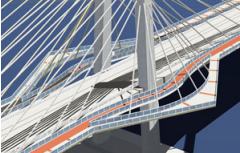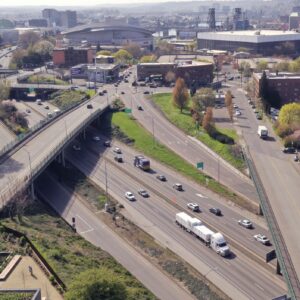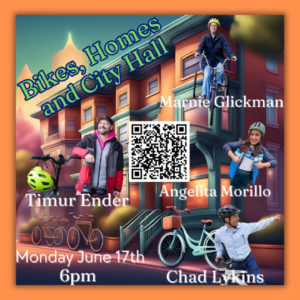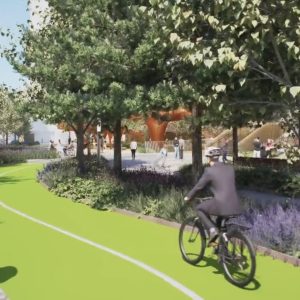
Last Thursday, The Oregonian’s top transportation reporter Dylan Rivera (he’s also their go-to guy for coverage of the new I-5 bridge/CRC project) took a closer look at the new TriMet multi-use transit bridge project. The story also included an audio slideshow titled, “Concept Bridge Creates Controversy” (watch it below).
In the article, Rivera delves into the capacity issues that currently exists on the Hawthorne Bridge (which is just north of where the new TriMet bridge will be) and seems to wonder whether or not the currently planned 14-foot wide path on the new bridge will be adequate (Hawthorne is 10 1/2-feet).
While it’s great to see The Oregonian reporting on whether a bike/ped path will be wide enough, it remains a mystery to us where they get the idea that the TriMet bridge project has been “controversial”.
In our story on this project last month, we reported that the City of Portland’s Bicycle Advisory Committee had written a letter in support of the 14-feet width (although they would have preferred more). Rivera’s article also includes a quote from the BTA’s Advocacy Manager Michelle Poyourow saying “14 feet will make a good design possible” and that it would “reduce tensions between bikes and pedestrians”.
So, where exactly is the controversy? Nowhere. Because there doesn’t seem to really be one (unless you count the many comments on The O’s story from people who are incensed that the bike/ped path is being built at all).
Despite this, unfortunately the O’s story has already been picked up by national transportation infrastructure blog, The Infrastructurist. They ran The Oregonian’s “Concept Bridge Creates Controversy” video and then assumed that “there’s still some jockeying between competing interests”.
The only “jockeying” going on right now (that we’ve heard about) is how exactly to best utilize (or “program” in planning-speak) the 14-feet of bike/ped space. That topic will be presented by TriMet and discussed by the City of Portland Bicycle Advisory Committee at their monthly meeting tomorrow night at City Hall.
Watch The Oregonian’s video below.
| Concept Bridge Creates Controversy |





Thanks for reading.
BikePortland has served this community with independent community journalism since 2005. We rely on subscriptions from readers like you to survive. Your financial support is vital in keeping this valuable resource alive and well.
Please subscribe today to strengthen and expand our work.
The only conflict is between the Oregoian and unbiased journalism.
…or between the Oregonian and the facts.
…between the Oregonian and financial success.
I could go on.
One controversy over the bridge has been architecural. Tri-Met chose a cheaper alternaive than the more expensive version that some architects preferred. I’m with Tri-met though on this. Spend a little less and get the bridge built.
“While it’s great to see The Oregonian reporting on whether a bike/ped path will be wide enough, it remains a mystery to us where they get the idea that the TriMet bridge project has been “controversial”.” bikeportland staff
There has been a lot of controversy surrounding the TriMet bridge from within Portland’s design…community… if you will. Portlandarchitecture’s editor Brian Libby has over recent months, posted a number of articles about this subject. I don’t think his site has a search function, so it may take a little effort to bring those articles up.
Relative cost of various bridge design options, the amount of money available, and how much the agency is willing to commit to the project has been a key factor in the controversy. Beauty and high functionality in a bridge design costs lots more money than a butt-ugly bridge that merely ‘does the job’. It’s seemingly been TriMets intention to go cheap and ugly, a direction which, if I’ve read correctly, they deny.
They appeared to backtrack from uglier design options they were thinking of. Now Portland has this design featured in the pics above to anticipate. Not bad, though again, cost…is a very tempting reason to not stretch and provide a wider pedestrian/bike component to the bridge. Wider than 14′ would probably be good, but cost lots more money that TriMet does not want to spend.
First off thank you for the wonderful site Jonathan. After reading the post I prepared myself for a news video that would be sensationalized, creating a controversy where there is none. After viewing the story I have to say that the use of the word “controversy” probably was not needed, but overall I thought it was good. It’s hard for me to be extra critical to that piece, it is 90% correct and the journalist sounds like a cyclist. I live in Honolulu Hawaii where talk about being bicycle friendly is just that, talk. Politicians talk about what they are doing, Master Bike Plan, etc. but don’t deliver. We look to Portland and other bike friendly cities for inspiration. It’s tough when you see all these great projects that favor cycling and walking (ugly or beautiful), and everyone being so sensitive about the minor stuff. Try to fix the minor stuff but play to the strengths. JMHO
The latest Trimet documents deal with quite a few options of the pedestrian/bicycle pathways:
Bridge Design Concepts
8 variations upon a theme.
Discuss.
Why the need to put the curves in the bike path. A straight path makes more sense. The less maneuvering to be done the safer the ride.
This bump out around the bridge pier can cause line of sight issues.
all projects are controversial to a degree (especially light rail transit). this aspect of this project has been one of the least controversial things about it.
Brian Libby speaks up (a lot) about preservation and I think that’s good. this time, however, i think he is being a drama queen.
mostly, the big arguments have been about the overall bridge design (previously it was the type). Dylan’s reporting wasn’t bad here, it was the headline on the video that was waaaay off – big surprise.
It seems to me that the bias on this site against the Oregonian is as bad as any bias that the ‘O’ pumps out (and please understand I am not defending the ‘O’).
Bias is bias. Let’s stop taking everything so personally. Based on the few comments here it appears the ‘O’ article is not without merit. Just my 2 cents.
thanks for the feedback on this folks. I appreciate that some feel I have a bias against The Oregonian.
that’s not the case. However, it is fair to say that I am very sensitive about how they report on bike issues… because after all they have the loudest voice in our city and state and they influence a lot of people.
I felt this bridge article was searching for a controversy when there wasn’t one so I felt it was important to set the record straight.
I also spoke with several very reliable sources close to these issues and this project who confirmed my feelings.
And just to be clear, I thought much of the article was great and I have a lot of respect for Dylan Rivera.
thanks.
#7 Canuck is spot on. There are ways to create visual interest OTHER THAN putting curves in the bridge. Those lanes begin to look like tightropes.
+1
Libby’s blog is poor. In particular, the typographical errors are on the level of a C average middle school student.
I suppose it depends how one defines controversy. The design process, particularly the final design for something like this bridge is very important…you might say…of critical importance to the city’s image and functionality in a number of different ways. The thing, once built will be there for decades, for everyone to see and critique. Portland residents that cross it daily will basically be living with it.
So, because there hasn’t been the kind of city-wide heated discussion going on about the bridge as has happened in past with other projects such as the tram, or perhaps the re-use proposal of the Sauvie Island bridge at Flanders St…some might not consider this bridge project controversial.
The controversy here seems to have kind of stayed within a relatively small segment of Portland residents. That doesn’t mean the project hasn’t been controversial. It has, and for good reasons. There seemed to be valid concern that, if people had not raised objections to some of the cheaper design options TriMet had in mind, Portland and its residents may have wound up with something awful. I felt like the ‘V’ support tower model was such an example.
Personally, I think I would have preferred an even more traditional styled bridge. Things change though, and not everyone likes, or wants to see something like the St. Johns Bridge copied. Re; the bike lane curving around the towers; don’t know for sure, but again, I’m guessing that’s to save money. Straight lanes would require a wider bridge…wouldn’t they? And that would mean more materials and labor in the project. The curves don’t seem to be so severe as to impair sight lines.
It’s ambitious to say the Oregonian has a bias here. Rather, the Oregonian has a broken business model, courtesy of the internet, and more specifically, Craigslist. As a general rule, 80% of revenue in media comes from advertising. Sources like the O once held a monopoly on widely distributed information but that was then and this is the internet now.
The Oregonian is losing money hand over fist. Another quarter another required set of furloughs, etc. for employees. The number of reporters continues to dwindle.
As the number of reporters dwindles, the quality of the coverage falls as well. Deadlines are greater and faster than ever before thanks to the 24 hour news cycle, and there are fewer bodies to crank out content. Of course the product is going to suffer. That’s why so many of us have ixnayed our subscriptions.
The part I don’t get is the injection of “controversy” into stories that don’t have it. I get the adage “if it bleeds it leads.” But to Maus’s point, there is no blood in this conversation about the width of the bike/ped span. To include the word “controversy” is totally sensationalist.
That’s been the pattern of late and that’s why so many of us look at this wafer-thin paper looking every bit the part of a tabloid with these ridiculous headlines, and are forced to conclude it’s not worth our dollars anymore. The way out of the broken business model is not sensationalism. That’s what the Oregonian isn’t getting.
It’s form over function.
This is not a tourist attraction. It’s a piece of transportation infrastructure. The first and most important goal is to fulfill the transportation needs.
This is a concept, does it even work from an engineering standpoint?
I’d rather have a civil engineer design this to do the job than have a designer come up with an plan that a n engineer then has to make work.
If I’m correct, the narrator of the video uses the words ‘war’ and ‘tense’ exactly once each. She speaks in a casual, matter of fact tone of voice with no apparent effort to dramatize or sensationalize the story. Even so, if I’d been advising the O staff, I think I would have suggested they not use the first word in telling this story.
Using that word as they did reasonably opens them up to certain complaints that they’re sensationalizing their story…to be ‘conversational’… perhaps, even if it’s not their intention to sensationalize. Use of that word just wasn’t necessary to tell the story accurately.
The second word though, ‘tense’, seems entirely appropriate, given the context of people riding bikes, and pedestrians traveling on foot, sharing limited space set aside for their use on some of Portland’s bridges. Wasn’t it this kind of tension that figured into the recent incident in which the actions of one person riding a bike contributed to the fall of another rider from the pedestrian/bike lane of the Hawthorne, into the main lanes of travel primarily used by motor vehicles?
This issue is partly why the bridge design and how much of its space is allotted to pedestrian/bike use is controversial.
Maus and elly blue…since it’s lengthy and for the most part off topic, I’ll certainly welcome you to delete the following remarks about the O from this comment. I did though, feel it important to respond to some of the above criticisms of the Oregonian’s reporting.
Regarding complaints about the O’s journalistic integrity, I’ve read a number of them made here in comments made on various threads of bikeportland. My impression is that the writers of them that resoundingly dismiss the O of having any worthwhile reporting or worthwhile reporters, don’t actually read the Oregonian. They might read just enough to give themselves material for a cheap shot…the high profile front page stories with bold headlines, but that’s about all.
I’d be surprised if they’re reading smaller stories inside the paper..for example, suburban and regional related stuff. They don’t seem to be reading anything the paper publishes that has to do with what’s going on outside of downtown Portland; Gresham, Damascus, Tigard, and so on.
The Oregonian is actually more than just the paper covering downtown; if I understand correctly, many of the suburban papers, Valley Times, Hillsboro Argus and more, have their own reporters assigned, and are under the O mast. The O carries some of the stories those papers publish, but not all.
Those that complain here seem to read and complain about conflicts between drivers and bicyclists…problems riding on public transportation with their bikes…criticism of the mayors behavior…but not much else. To them, those types of reporting seem to be all the paper is worth reading for.
To those that choose to read no further in the O than that, I say…suit yourselves. The paper can and does provide quality reporting and writing and makes it available to you. If you want the information available inside, you’ve got to make the effort to actually pick up the paper and read it.
I read the Oregonian’s article and I did apreciate that they were apparently in favor of more bike pedestrian space. I am surprized to learn that people were upset about the bike and pedestrian space on the bridge though. It’s hard to understand the bike haters, especially when there’s a project that takes cyclists and puts us in a whole diferent area; effecively getting us “out of their way”
Interesting that at 20 seconds they seeming speed up the film as the bikes cross the lane markers, making it look like the riders are going 25-30mph. I thought that kind of manipulation was frowned upon in journalism.